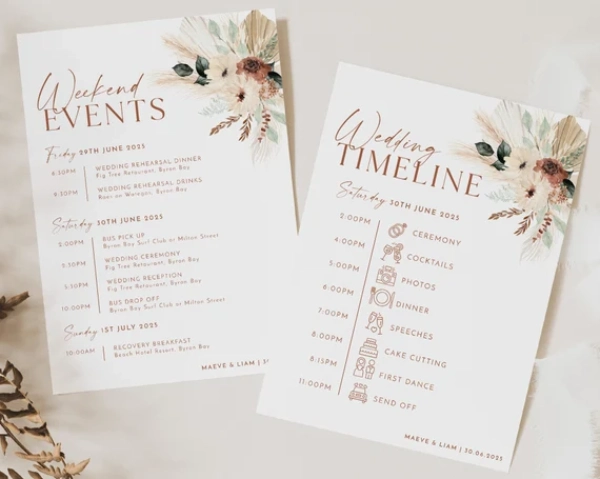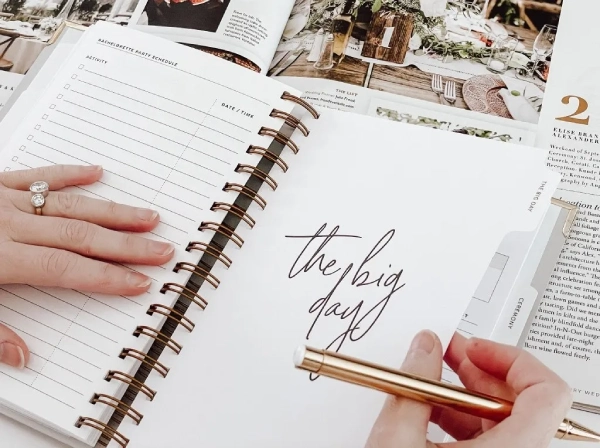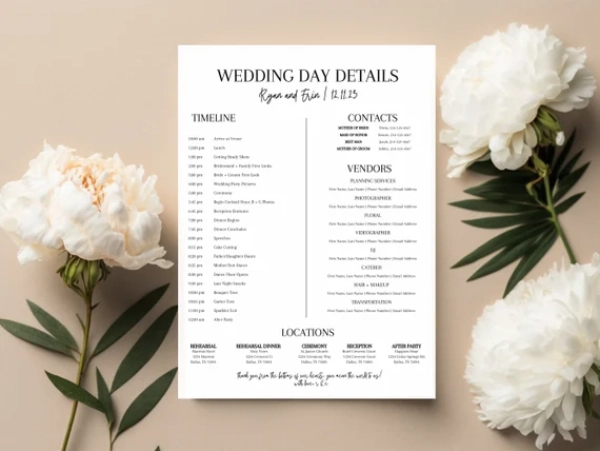Planning a wedding can be an exciting but overwhelming experience, with countless details to consider. One crucial element that can make or break your big day is the wedding day timeline. Creating a well-structured and thought-out timeline will ensure a smooth flow of events and keep everything on track.
In this article, we will guide you on what to include in your wedding day timeline to ensure a seamless and stress-free celebration. From getting ready in the morning to the final send-off, we’ll cover all the essential activities and events you need to account for. Whether you’re having a small intimate ceremony or a grand affair, a well-planned timeline will help you stay organized and enjoy your day to the fullest.
We’ll dive into everything from hair and makeup schedules, pre-ceremony photoshoots, and ceremony and reception timings. We’ll also explore how to incorporate important moments such as the first look, speeches, cake cutting, and the all-important first dance. By following these tips, you’ll be able to craft a wedding day timeline that creates a smooth and memorable experience for you and your guests.
Read on to discover the key elements to include in your wedding day timeline and ensure that your special day runs like clockwork.
Importance of a wedding day timeline
Creating a wedding day timeline is crucial because it serves as the backbone for your entire celebration. Without a structured plan, the day can quickly become chaotic, leaving you feeling stressed and overwhelmed. A well-crafted timeline helps ensure that everything from the ceremony to the reception flows smoothly, allowing you and your guests to enjoy the festivities without the burden of uncertainty hanging over your head. When all parties know what to expect and when, it creates a more enjoyable atmosphere for everyone involved.
Moreover, a timeline allows you to allocate specific times to important activities, ensuring that nothing gets overlooked or rushed. By scheduling events such as the first look, cocktail hour, and speeches, you provide your vendors, bridal party, and family members with a clear understanding of their roles and responsibilities throughout the day. This level of organization not only contributes to a smoother event but also minimizes stress, allowing you to focus on the most important aspect—celebrating your love with family and friends.
Lastly, a wedding day timeline helps you make the most of your time. With so many events packed into one day, it’s easy to lose track of time. Having a detailed schedule ensures that you can enjoy each moment without feeling the pressure of the clock. It allows you to savor the small things, like spending time with loved ones during the cocktail hour or taking in the joy of your first dance. Ultimately, a well-thought-out timeline is the key to a memorable and enjoyable wedding day.
Preparing for the wedding day timeline
The first step in preparing your wedding day timeline is to gather all the essential information about your day. Start by considering the venue’s requirements and constraints, as these can significantly influence your schedule. Understanding the timing of the ceremony, the duration for setting up the reception area, and any restrictions on when vendors can arrive will help shape your timeline. Additionally, discuss your vision with your wedding planner or coordinator, as their expertise can provide valuable insights into what works best for your specific situation.
Next, it’s important to account for the various elements of your day. Common components to consider include hair and makeup schedules, transportation times, and the duration needed for each event. A detailed itinerary should include the arrival times for vendors, the bridal party, and any family members who play key roles. Take the time to outline how long each activity will take, considering potential delays or unforeseen circumstances. This preparation phase is essential to ensure that everything aligns perfectly on the day itself.
Lastly, communication is vital in this preparation process. Share your timeline with all key participants, including your bridal party, family members, and vendors. Make sure everyone understands their roles and when they are expected to be ready. This helps prevent any confusion or last-minute surprises. Regular check-ins as the wedding day approaches can also help keep everyone on the same page. By preparing thoroughly and communicating effectively, you set the stage for a seamless wedding day timeline.
Getting ready: hair, makeup, and dressing
One of the first segments of your wedding day timeline should focus on the getting-ready process. This is a cherished time for the couple, especially for the bride and her bridal party, allowing for excitement, laughter, and bonding before the ceremony. Start by allocating ample time for hair and makeup appointments, as well as getting dressed. Typically, the bride should plan for at least 4-6 hours for this process, depending on the size of the bridal party and the complexity of the hairstyles and makeup. This ensures that there’s enough time for touch-ups and any potential delays.
It’s also essential to consider the location for getting ready. Whether you choose to do this at your home, a hotel, or the wedding venue itself, make sure the space is comfortable and has good lighting for both makeup application and photography. Prepare a checklist of everything you need to have on hand, such as dresses, accessories, shoes, and personal items. This checklist will help streamline the process and ensure that nothing is forgotten in the hustle and bustle.
Finally, during this time, it’s important to capture memories through photography. Schedule a photographer to document candid moments as you and your bridal party prepare for the day. This not only adds to the timeline but also allows for beautiful memories of the anticipation and joy leading up to the wedding ceremony. By effectively planning the getting-ready segment of your timeline, you create a joyful and relaxed atmosphere that sets a positive tone for the rest of the day.
Ceremony timeline: arrival, processional, vows, and recessional
The ceremony is often the most anticipated part of the wedding day, so a well-planned timeline is essential to ensure that this moment unfolds beautifully. Start by outlining the arrival times for the wedding party, guests, and officiant. Typically, guests should begin arriving about 30 minutes before the ceremony is set to start, giving them ample time to find their seats and settle in. Ensure that your timeline accounts for any transportation needs and potential traffic delays, as this can be a common source of stress on the wedding day.
Next, plan the processional order. This includes the entrance of the wedding party, the bride, and any special family members. Assign approximate times for when each person should walk down the aisle, which helps maintain a smooth flow. It’s also beneficial to discuss this timeline with your officiant, as they can provide guidance on how long each part of the ceremony will take, including readings, vows, and any special rituals you may want to include.
Once the vows have been exchanged, it’s time to consider the recessional. This marks the conclusion of the ceremony and the beginning of the celebration. Plan for a short period immediately following the ceremony, allowing guests to congratulate you and take photos before transitioning to the next segment of the day. By carefully structuring the ceremony timeline, you ensure that this momentous occasion is not only beautiful but also organized, allowing you to focus on the love and joy surrounding you.
Cocktail hour: timing and activities
After the ceremony, the cocktail hour offers a wonderful opportunity for guests to mingle and celebrate. Typically lasting about one hour, this period allows you to take care of any necessary post-ceremony photos while your guests enjoy drinks and appetizers. When crafting your timeline, it’s essential to coordinate with your caterer to ensure that food and beverages are readily available when guests arrive. This not only keeps everyone satisfied but also sets a positive tone for the rest of the evening.
Incorporating activities during the cocktail hour can enhance the experience for your guests. Consider setting up a photo booth with props, creating a signature cocktail for the evening, or having live music or a DJ to entertain the crowd. If your venue allows, you could also include lawn games or other interactive elements that encourage guests to engage with one another. When planning these activities, ensure they fit within the allotted time and do not detract from the primary focus of the day: the celebration of your love.
Finally, don’t forget to schedule time for the newlyweds to make their grand entrance into the reception following the cocktail hour. This moment should be memorable and exciting, so plan for a specific time to transition from cocktails to the reception. Communicate this with your DJ or band, as they will need to set the stage for your entrance. By thoughtfully planning the cocktail hour, you can create a vibrant atmosphere that allows everyone to celebrate and connect while you prepare for the next phase of your wedding day.
Dinner and dancing: meal service, open dance floor, and special moments
The dinner and dancing portion of your wedding day is where the celebration truly comes alive. This segment generally involves meal service, toasts, and dancing, all of which should be carefully outlined in your timeline. Begin by coordinating with your caterer to establish the timing for meal service, ensuring that food is served promptly and at the right temperature. You may want to consider a buffet or plated service, depending on your preference and the atmosphere you wish to create.
After dinner is served, it’s time to incorporate special moments that add a personal touch to your celebration. This includes speeches from the best man, maid of honor, and family members. Allocate time for these toasts, so they don’t feel rushed and can be enjoyed by everyone. You might also want to plan for the cutting of the cake and the first dance, both of which are significant moments that should be highlighted in your timeline. By planning these special moments, you create lasting memories not just for yourselves but for your guests as well.
As the night progresses, the dance floor will become a focal point of the celebration. Plan for a designated time when dancing will officially begin, allowing guests to let loose and enjoy the festivities. If you have specific songs you want to incorporate, share these with your DJ or band in advance to ensure they can accommodate your preferences. By organizing this segment of your wedding day timeline, you can create a joyful and engaging atmosphere that encourages everyone to celebrate your love.
Timeline for photography and videography
One of the most important aspects of your wedding day is capturing the moments through photography and videography. To ensure that you get the most out of your investment in these services, it’s essential to create a detailed timeline that outlines when and where photos will be taken. Start by scheduling time for pre-ceremony shots, including getting ready photos, first look moments, and bridal party portraits. It’s advisable to allocate at least an hour for this portion, ensuring that you can capture all the essential details without feeling rushed.
During the ceremony, your photographer and videographer will be focused on capturing the key moments, but it’s also wise to discuss specific shots you want beforehand. Consider creating a shot list that includes family portraits, candid moments with guests, and any special traditions you want documented. Share this list with your vendors to ensure they know your preferences and can plan accordingly. This level of preparation will help ensure that no important memories are missed.
Finally, don’t forget to schedule time for post-ceremony photos as well. This often includes family portraits and couple shots at scenic locations. Plan for at least another hour for this segment, as it can take time to gather family members and capture the desired images. By thoughtfully incorporating photography into your wedding day timeline, you ensure that every cherished moment is preserved, allowing you to relive the joy of your wedding day for years to come.
Managing unexpected delays or changes
Despite the best of planning, weddings can be unpredictable, and managing unexpected delays is a crucial aspect of your wedding day timeline. Factors such as weather conditions, traffic, or late arrivals can all impact your schedule. To mitigate stress, it’s important to build some buffer time into your timeline. For instance, if the ceremony is set for 3 PM, consider planning for guests to start arriving at 2:30 PM, allowing a little wiggle room for any delays that may arise.
Additionally, appointing a reliable point person—such as a wedding planner, trusted friend, or family member—can be invaluable in managing any hiccups throughout the day. This individual can communicate with vendors, guests, and the bridal party, allowing you to focus on enjoying your celebration without getting bogged down by logistical issues. Make sure this person is aware of the timeline and understands how to make adjustments as needed.
Finally, maintaining a flexible mindset is essential. Accept that things may not go exactly as planned, and that’s okay. Embrace the spontaneity of the day and remember that the most important thing is celebrating your love. If something goes awry, take a deep breath, and trust that your carefully crafted timeline has provided a solid foundation for a beautiful day. By preparing for potential changes and remaining adaptable, you can ensure that your wedding day remains a joyous occasion.
Finalizing the wedding day timeline
As your wedding day approaches, it’s time to finalize your timeline. Start by reviewing all the details you’ve gathered and make any necessary adjustments. Confirm all the timings with your vendors to ensure everyone is on the same page. This includes the florist, photographer, caterer, and venue staff. Having a cohesive plan in place will help create a seamless flow of events and ensure that everyone knows their responsibilities.
Once you’ve confirmed the timeline with your vendors, distribute the finalized version to all key participants, including your bridal party, family members, and anyone involved in the ceremony or reception. This ensures that everyone understands the schedule and can prepare accordingly. Consider printing copies of the timeline for your bridal party and vendors, so it’s easily accessible on the day of the wedding.
Finally, as the big day arrives, allow yourself to feel excited and embrace the moment. Trust that your meticulous planning will pay off and that you’ve created the framework for a memorable celebration. Keep in mind that while a timeline is a valuable tool, it’s okay to deviate from it slightly if the moment calls for it. The goal is to enjoy your wedding day, surrounded by the love of family and friends. By finalizing your timeline and remaining open to the experiences of the day, you’ll create a beautiful and unforgettable wedding celebration.





